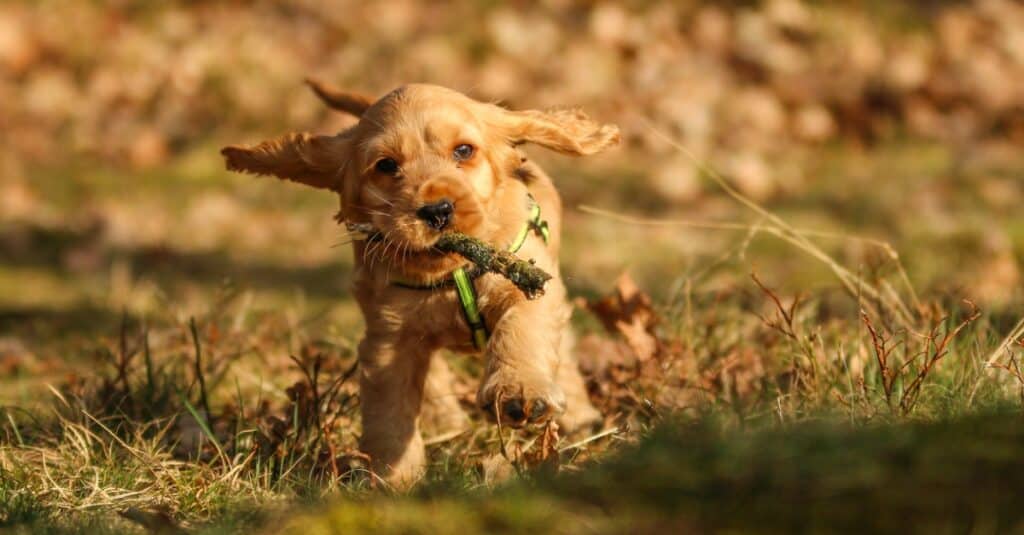The cocker spaniel is a well-known and beloved dog breed. Their silky fur and expressive eyes lock you in initially, only to completely win you over with their affectionate personality. They form strong bonds with their owners and love nothing more than spending time with those they love, making them one of the best family dogs around.
The cocker spaniel is believed to trace back to an ancient spaniel family from Spain. They were initially known for their impressive hunting skills of the woodcock bird, likely leading to the ‘cocker’ portion of their name. These pups were eventually imported to the United States to aid bird and duck hunters, and it soon became clear that they make wonderful companions. The cocker spaniel we know and love today is active, energetic, and kind-natured.
Once you decide that a cocker spaniel is the right dog for your family, you may wonder if you should adopt a male or female. There are a six key differences between the male and female cocker spaniel, so let’s break down everything you need to know below!
1. Physical Differences

The beloved cocker spaniel weighs anywhere from 20 to 32 pounds and can be 13 to 17 inches tall.
©Aneta Jungerova/Shutterstock.com
The male tends to be slightly larger than the female.
Male: Males are often slightly larger than females. They are 14-17 inches tall on average and weigh anywhere from 20 to 32 pounds.
Female: Females tend to be a bit smaller than males. While males can weigh anywhere from 20 to 32 pounds, females tend to weigh 20 to 25 pounds on average.
2. Temperamental Differences

Cocker spaniels are affectionate, loyal, and kind-natured. They make wonderful family dogs.
©iStock.com/undefined undefined
Both males and females are highly affectionate. They are known to form close bonds with their owners, and they enjoy nothing more than spending time with the people they love.
Male: While both male and female cocker spaniels are affectionate and kind-natured, cocker spaniel parents believe that males are more loving. Male cockers are said to form close bonds with all members of the family instead of just one, and they are said to seek out attention more often than females do.
Female: Female cocker spaniels are a bit less attention-seeking than their male canine friends. They still love spending time with their owners, but they are more content with playing on their own or with other canine friends.
3. Trainability Differences

Cocker spaniels are easy to train if they have a program that is positive, engaging, and reward based.
©Eric Isselee/Shutterstock.com
Cocker spaniels are known for being an intelligent breed. They are often easy to train due to their history of working alongside humans, but they can be a bit stubborn at times.
Male: Male cocker spaniels can catch on to training concepts very quickly, but they can be a bit stubborn at times. Male cocker spaniels may wander off and become distracted if their training program is not highly engaging and positive.
Female: Training a female cocker spaniel is typically easier than training a male. Female cocker spaniels are known for being more focused and less likely to fall victim to distraction throughout their training program.
4. Health Differences

The average lifespan of the cocker spaniel is 12 to 15 years.
©everydoghasastory/Shutterstock.com
Both males and females are predisposed to medical conditions such as cherry eye, ear infections, skin infections, progressive retinal atrophy, cardiac disease, and obesity.
Male: There are not many health differences between males vs. females. However, intact males can develop reproductive cancers and infections that impact their testicles, penis, and prostate.
Female: Intact females can develop reproductive cancers and infections that impact their mammary tissues and uterus.
5. Relationships with Other Pets

This breed can struggle with fearfulness around other dogs if not well-socialized during puppyhood.
©Alkhaine/Shutterstock.com
The cocker spaniel is generally friendly and calm around other pets when they are well-socialized. However, they can struggle with shyness or fearfulness if they are not introduced to other dogs during puppyhood.
Male: The male is generally friendly and calm arounds other dogs. However, intact males that are not well-socialized may struggle with mild aggression around other unfamiliar canine friends. This is usually a response out of fear.
Female: The female is known for being shyer than the male when interacting with other dogs. Introducing them to other dogs during puppyhood can help them feel more confident around new pups!
6. Relationships with Children

These dogs thrive with children!
©Olga Aniven/Shutterstock.com
The cocker spaniel is the perfect addition to any home with children. They are kind-natured and gentle, and they love engaging in playtime with their family. Cocker spaniels thrive in a home with kids that understand basic canine boundaries and respect.
Male: The male does especially well with children. Males tend to be a bit clingier and more social, so this often pairs well in a home with kids that love to play with their pup. A male makes for a wonderful companion!
Female: Females are a bit more independent than males, but they still do well with children. Just be sure that your children understand basic canine boundaries, as the female may be more inclined to snap if they are not handled with care.
Summary On Male & Female Cocker Spaniels
Male and female cocker spaniels may differ slightly when it comes to their physical appearance, training abilities, temperament, and health. Be sure to review the information above to determine which gender is the right fit for your family!
The photo featured at the top of this post is © iStock.com/Bigandt_Photography
Ready to discover the top 10 cutest dog breeds in the entire world?
How about the fastest dogs, the largest dogs and those that are -- quite frankly -- just the kindest dogs on the planet? Each day, AZ Animals sends out lists just like this to our thousands of email subscribers. And the best part? It's FREE. Join today by entering your email below.
Thank you for reading! Have some feedback for us? Contact the AZ Animals editorial team.







